
PREV ARTICLE
NEXT ARTICLE
FULL ISSUE
PREV FULL ISSUE
MORE COLONIAL SELECTIONS FROM NEWMAN PART VAt my request Maureen Levine forwarded me text and images for some more headline
lots in the upcoming Heritage sale of Part V of the Eric P. Newman collection. Thanks!
-Editor
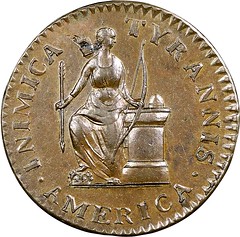 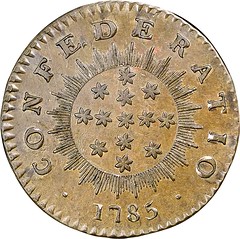 1785 Inimica Tyrannis Cent
The obverse motto, "America Opposed to Tyranny," was taken from a longer Latin phrase, "Manus haec inimica tyrannis ense petit placidam sub libertate quietem," attributed to Algernon Sidney circa 1659. Sidney was an English soldier and statesman was opposed to King Charles II; he was executed for treason in 1683. A notice in the November 20, 1755 edition of The Pennsylvania Gazette described Sidney as a "Friend of Peace." The second half of the Latin passage is the official motto of the Commonwealth of Massachusetts. The Large Stars Confederatio pieces are known as decads, the name given to a copper coin valued at approximately one hundredth of a Spanish dollar. A sketch of the design appeared in the papers of the Continental Congress in 1785, and is considered by some as an important pattern issue. There's a numismatic term I wasn't familiar with before: decads.
-Editor
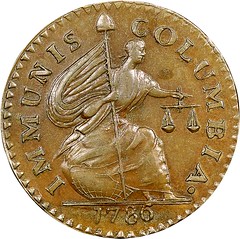
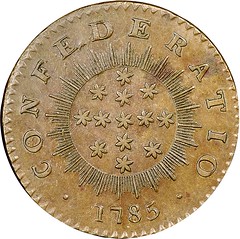 1786/85 Immunis Columbia, Confederatio Mule
Facts about these pieces are extremely limited and confusing. A series of coins including various combinations of the Immunis Columbia obverse, the Confederatio reverse, and related dies, includes a mule of the 1786 Immunis Columbia obverse and the New Jersey shield reverse, also offered in the present sale. The various pieces are recorded in the Whitman Colonial Encyclopedia under catalog numbers 5630-5700, listing 14 different varieties. These pieces are also punch-linked to the Nova Constellatio coppers of 1783 and 1785. Eric P. Newman believes that these coins, including the Nova Constellatio coppers and the Immunis Columbia pieces, were produced in England, probably at Wyon's Birmingham Mint. Earlier numismatic scholars, including Sylvester S. Crosby held the same belief in the 19th century. More recently, other researchers, including Michael Hodder, have developed an alternative viewpoint that the coins were produced in America.   1785 Washington Confederatio Copper
The General Washington obverse die is seen here with the Confederatio Large Circle reverse; it is also known with the New Jersey Shield reverse die C, and the 1786 Heraldic Eagle die, obverse 5 in the New Jersey series. The New Jersey mule lends credence to these pieces being American colonial issues, rather than products of England. However, facts about these coins are just as rare as the coins themselves. 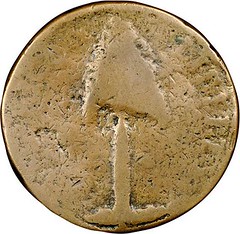  1776 New Hampshire Copper
Facts about these coppers are limited and surviving examples are extremely rare, although reproductions are commonplace. In his book, In Yankee Doodle’s Pocket, Will Nipper writes: "New Hampshire patterns are so rare that the probability of encountering a genuine specimen is almost zero. Yet, copies number in the millions." 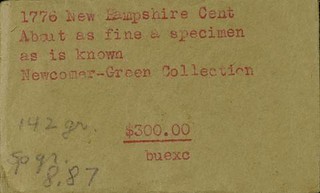 Mark Borchardt of Heritage provided this image
of the storage envelope from the Newman collection. Thanks! -Editor Mark Borchardt of Heritage provided this image
of the storage envelope from the Newman collection. Thanks! -EditorFor more information, see:
To read the earlier article, see:
THE BOOK BAZARREWayne Homren, Editor The Numismatic Bibliomania Society is a non-profit organization promoting numismatic literature. See our web site at coinbooks.org. To submit items for publication in The E-Sylum, write to the Editor at this address: whomren@gmail.com To subscribe go to: https://my.binhost.com/lists/listinfo/esylum All Rights Reserved. NBS Home Page Contact the NBS webmaster 
|